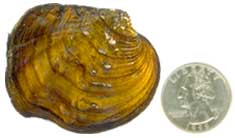 |
 | |
  | |
|
|
|
|
Mississippi National River and Recreation Area
Winged Mapleleaf
|
|
|
|
|
|
 |
(Quadrula fragosa) Conrad, 1835
|
|

|
| K.S. Cummings, Illinois Natural History Survey |
|
| | | |
False mapleleaf; Hickorynut shell.
|
| | |
Medium to large rivers in mud, sand, or gravel.
|
| | |
Up to 4 inches (10.2 cm).
|
| | |
Varies. May be yellowish green or light brown. Young mussels may have faint rays.
|
| | |
White, with iridescent coloring on one end.
|
| | | | | |
Entire shell outline looks somewhat like an inflated square. The beak(above the point where the two shell halves join), makes up one "corner" of the square. The shell edge closest to the beak is rounded, and the edge farthest away from the beak is squared off.
|
| | |
The Entire outer surface may look somewhat swollen or bulged-out, and the outer surface is mostly rough. There is a triangular flattened extension of the shell that resembles a wing: running your finger along its outer surface, you will feel many small bumps radiating out. There are two ridges on the outer shell surface, which are made up of many pimple-like bumps. These ridges run from the point where the two shell halves meet to the opposite shell edge. The area between the two ridges is smooth (no pimple-like bumps), and looks slightly pressed-in (it looks similar to the pressed-in mark the length of your finger would make on wet clay).
|
| | |
Shell quadrate or square, thick, moderately inflated. Anterior end rounded, posterior end truncated. Dorsal margin straight, ventral margin curved in the anterior half, arched posteriorly. Pronounced ala present posterior to the umbo, with radiating rows of pustules or ridges. Beak sculpture of two raised bumps or nodules that continue downward on the surface of the shell, separated by a sulcus. Periostracum variable. Nacre pearly white, iridescent posteriorly.
|
| | | | | | | | |
Only known extant population in the Midwest occurs in Wisconsin.
|
| | | | | | | | | |
|
|  |

|
 |
|
|
|
|
|
 |
|
Did You Know?
At Lake Onalaska, near LaCrosse Wisconsin, the Mississippi River is about 4 miles wide. Mississippi River water held behind Lock and Dam #7 and water held by damming the Black River form this broad reach of the Mississippi River.
|
|
|
|
Last Updated: September 20, 2006 at 15:02 EST |






